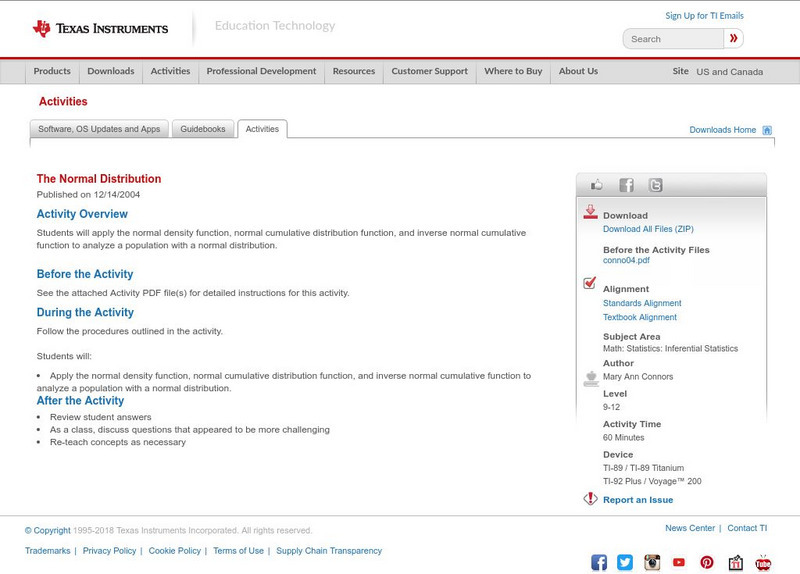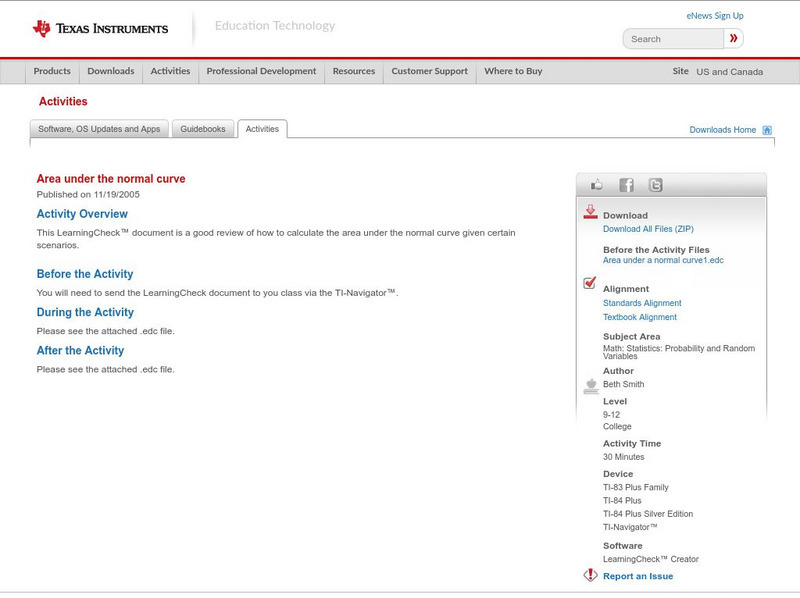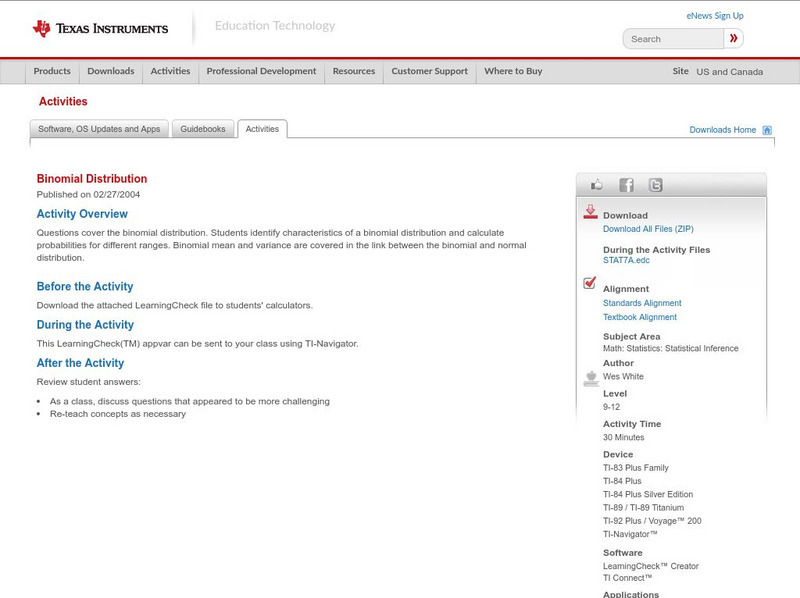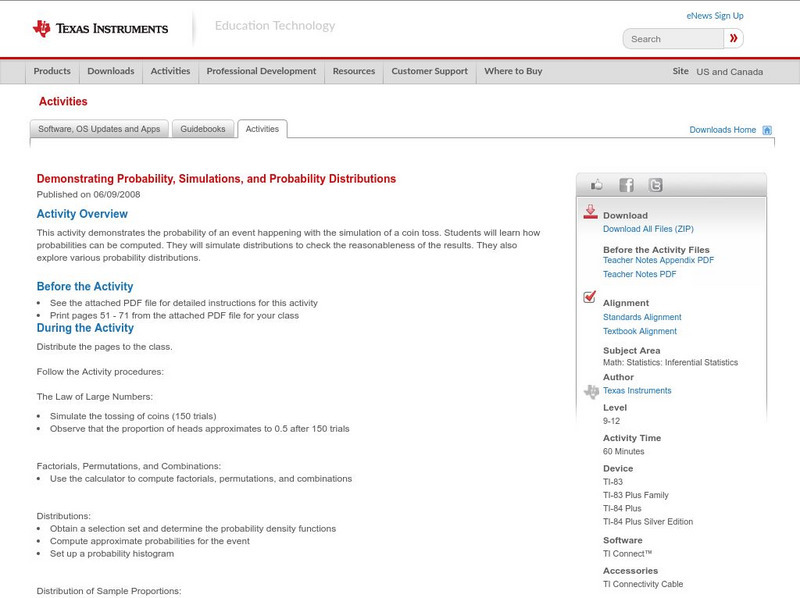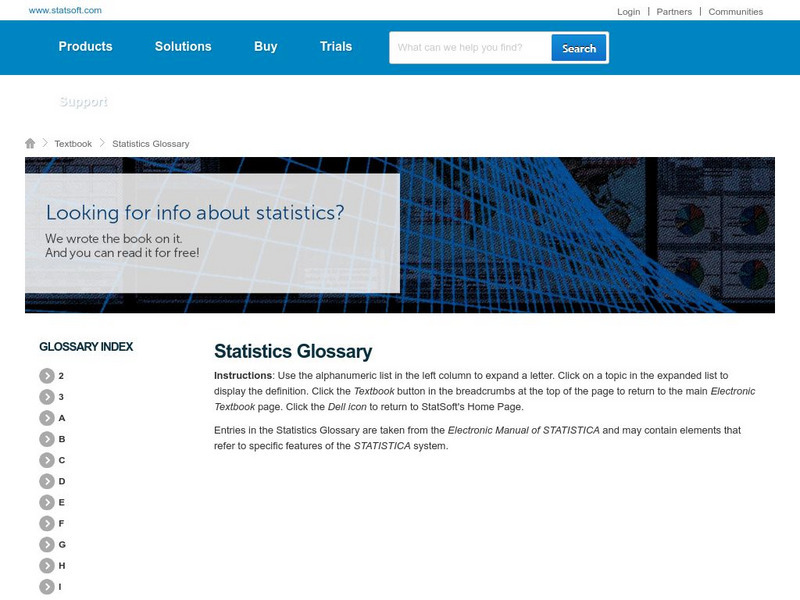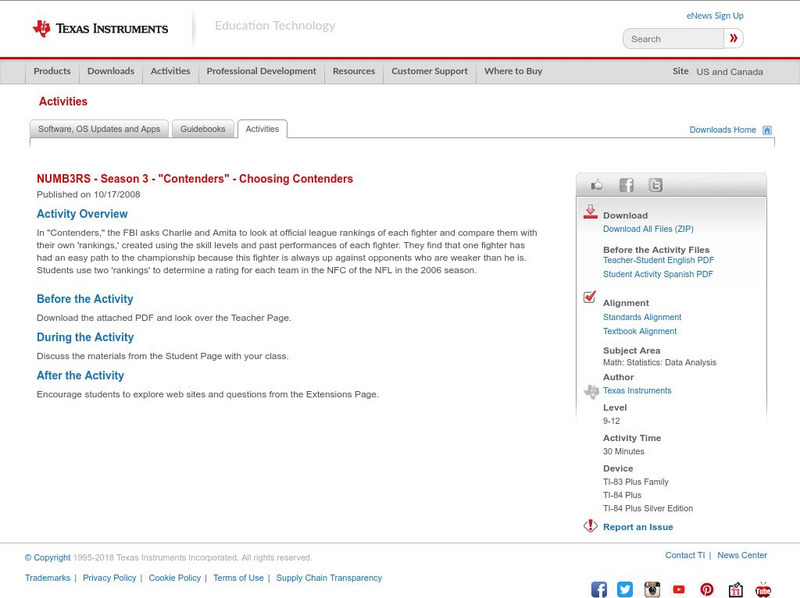Texas Instruments
Texas Instruments: The Normal Distribution
In this activity, students will apply the normal density function, normal cumulative distribution function, and inverse normal cumulative function to analyze a population with a normal distribution.
Texas Instruments
Texas Instruments: The Normal Distribution
Students graph normal distributions, shade desired areas, and find related probabilities. They graph Normal probability scatter plots to check the normal (linear) shape of a data distribution.
Texas Instruments
Texas Instruments: Normal Distribution
This set contains statistics questions regarding the normal curve, its distribution, and its applications. The student, using the correct calculation, transitions between observed x-values, standard z-scores, and normal curve areas.
Texas Instruments
Texas Instruments: Plums and the Normal Distribution
This lesson demonstrates how the calculator's built-in numeric solver can be used along with the normalcdf function to answer a variety of Normal Distribution questions.
Texas Instruments
Texas Instruments: Special Cases of Normally Distributed Data
Students perform single and two-sample t procedures to investigate special cases of normally distributed data. They explore inference for a least-square regression line, including the confidence interval.
Shodor Education Foundation
Shodor Interactivate: Normal Distribution
Change the standard deviation of an automatically generated normal distribution to create a new histogram. Observe how well the histogram fits the curve, and how areas under the curve correspond to the number of trials.
Texas Instruments
Texas Instruments: Area Under the Normal Curve
This LearningCheck document is a good review of how to calculate the area under the normal curve given certain scenarios.
Oswego City School District
Regents Exam Prep Center: Normal Distribution
The mathematics tutorial investigates the normal distribution. The lesson consists of class notes, calculator tips, examples, and practice problems with solutions. The teacher resource includes an activity that examines the normal...
Texas Instruments
Texas Instruments: Binomial Distribution
Questions cover the binomial distribution. Students identify characteristics of a binomial distribution and calculate probabilities for different ranges. Binomial mean and variance are covered in the link between the binomial and normal...
Texas Instruments
Texas Instruments: Numb3 Rs: Galton Board
Based off of the hit television show NUMB3RS, this lesson has students find the probability of chips falling into each bin of a Galton Board (also known as a quincunx or Plinko board), and then graphing these data to form a normal curve....
Shodor Education Foundation
Shodor Interactivate: Skew Distribution
Change the median and standard deviation of an automatically generated normal distribution to create a skewed distribution, allowing you to observe properties like what it means for the mean, median, and mode to be different.
Other
Berrie's Statistics Page: Normal Distribution
Site discusses the normal distribution as well as the mean and variance in the normal distribution. A link is provided for a QuickTime activity to adjust the mean.
Texas Instruments
Texas Instruments: Probability Distributions
In this activity, students use the Derive software to compute binomial, hypergeometric, standard normal and normal probabilities, and explore inverse normal computations.
Texas Instruments
Texas Instruments: Probability, Simulations, and Probability Distributions
Use simulation on the TI-83 graphing calculator to teach students about the distribution of sample proportions, distribution of sample means, the Central Limit Theorem, normal probability plots, and the Law of Large Numbers. Pick and...
Texas Instruments
Texas Instruments: Sampling Distributions
Students study the distribution of sample proportions with a simulation. They find a small sample size leads to skewed distribution and as the sample size increases, the distribution becomes more normal.
University of Cambridge
University of Cambridge: Maths and Sports: Who's the Best?
Can you use data from the 2008 Beijing Olympics medal tables to decide which country has the most naturally athletic population? This data-handling activity encourages mathematical investigation and discussion and is designed to be...
University of Cambridge
University of Cambridge: Maths and Sports: Olympic Triathlon
Do you think the triathlon will be won by someone who is very strong in one event and average in the other two, or someone who is strong in all three disciplines? This activity challenges students to analyse real-life data and use their...
Other
Stat Soft: Statistics Glossary
Dozens of statistical terms are defined and illustrated in this glossary.
Texas Instruments
Texas Instruments: Numb3 Rs: Choosing Contenders
Based off of the hit television show NUMB3RS, this lesson shows students two different ways to "normalize" scores: by applying a created scalar factor so that all scores have a mean of one, or by using z-scores. Students are walked...
Texas Instruments
Texas Instruments: Using Derive
In this activity, students use the Derive software to solve trigonometric equations, expressions with exponentials, and log equations. They also determine the equation of tangent and normal of a function; evaluate integrals, find area...
Texas Instruments
Texas Instruments: Central Limit Theorem
This set contains questions regarding the Central Limit Theorem. The student sees that, as the size n increases, the shape of the sampling distribution gradually approaches a normal curve, and its population standard deviation decreases.
Shodor Education Foundation
Shodor Interactivate: Overlapping Gaussians
In this applet you can adjust the parameters on two Gaussian curves to determine if there is a possibility of a difference between the two means.
